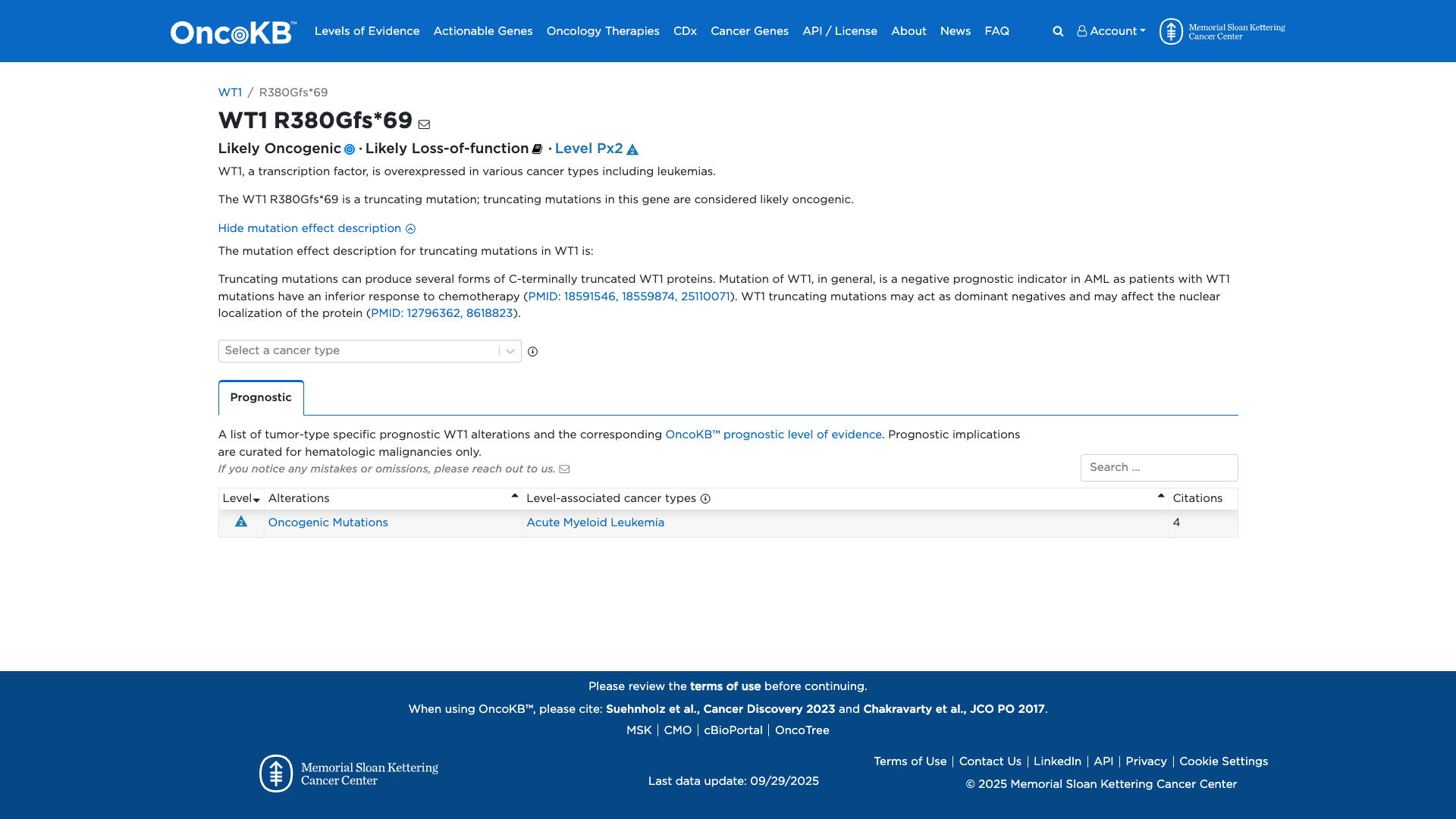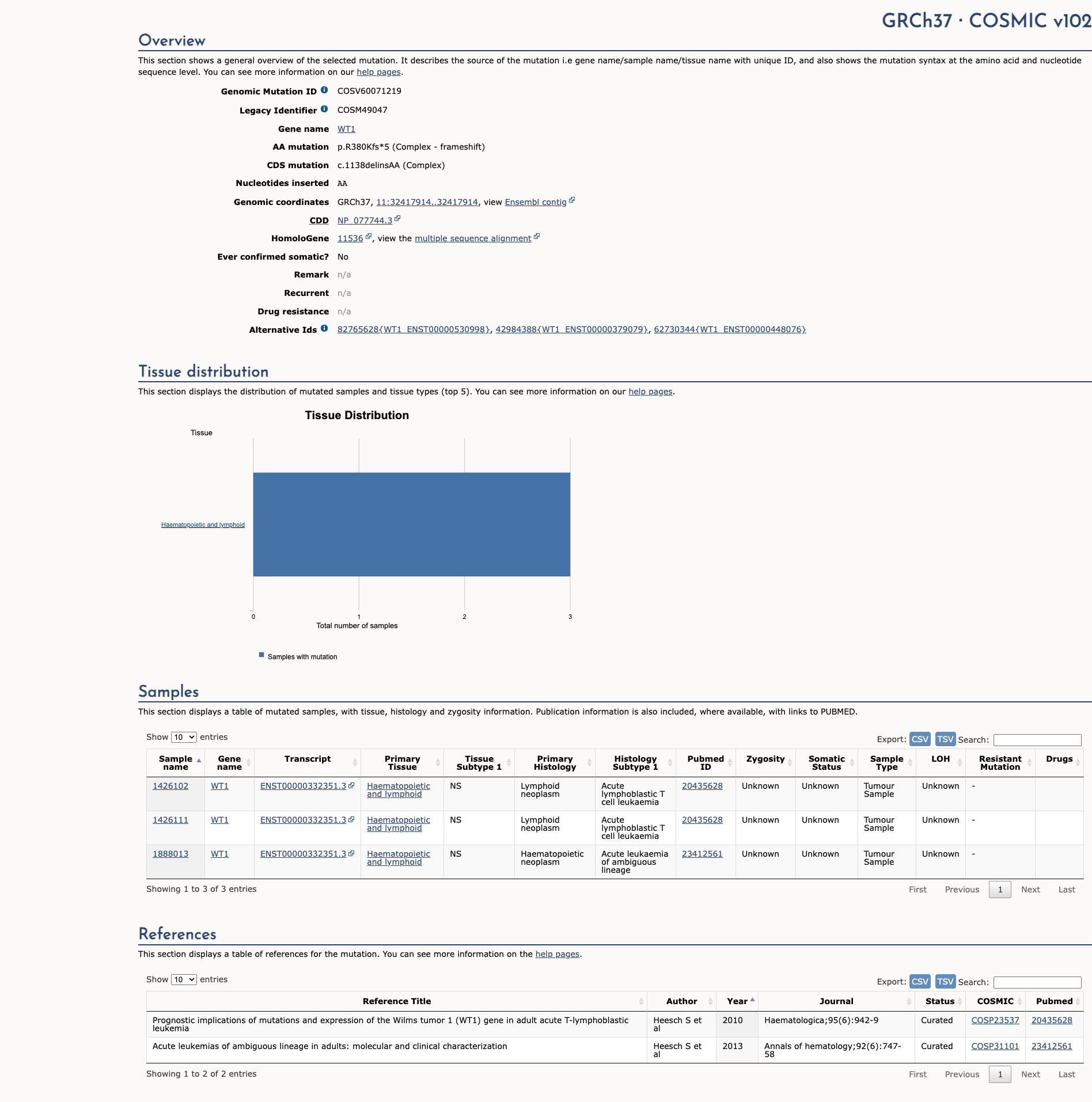WT1 c.1138del, p.Arg380GlyfsTer69
NM_024426.4:c.1138del
Pathogenic
NM_024426.4:c.1138delC (R380Gfs*69) in WT1 is classified as Pathogenic based on PVS1 (Very Strong), PS3 (Strong), and PM2 (Moderate), reflecting a truncating loss-of-function variant absent from controls with supporting functional data.
ACMG/AMP Criteria Applied
PVS1
PS3
PM2
Genetic Information
Gene & Transcript Details
Gene
WT1
Transcript
NM_024426.6
MANE Select
Total Exons
10
Strand
Reverse (−)
Reference Sequence
NC_000011.9
Alternative Transcripts
| ID | Status | Details |
|---|---|---|
| NM_024426.4 | Alternative | 10 exons | Reverse |
| NM_024426.5 | RefSeq Select | 10 exons | Reverse |
| NM_024426.3 | Alternative | 10 exons | Reverse |
Variant Details
HGVS Notation
NM_024426.4:c.1138del
Protein Change
R380Gfs*69
Location
Exon 7
(Exon 7 of 10)
5'Exon Structure (10 total)3'
Functional Consequence
Loss of Function
Related Variants
No evidence of other pathogenic variants at position 380 in gene WT1
Variant interpretation based on transcript NM_024426.6
Genome Browser
Loading genome browser...
HGVS InputNM_024426:c.1138del
Active Tracks
ConservationRefSeqClinVargnomAD
Navigation tips: Use mouse to drag and zoom. Click on features for details.
Clinical Data
Population Frequency
Global Frequency
0.0 in 100,000
Extremely Rare
Global: 0.0%
0%
0.05%
0.1%
1%
5%
10%+
ACMG Criteria Applied
PM2
This variant is not present in gnomAD (PM2 criteria applies).
Classification
Unknown
Publications (0)
No publication details.
Clinical Statement
Functional Impact
Functional Domain
Hotspot Status
Not a hotspot
Domain Summary
This variant is not located in a mutational hotspot or critical domain (0 mutations).
Related Variants in This Domain
No evidence of other pathogenic variants at position 380 in gene WT1
Functional Summary
Loss-of-Function
The WT1 R380Gfs*69 variant is a truncating mutation that has been functionally characterized as likely loss-of-function. Truncating mutations in WT1 are considered likely oncogenic, potentially acting as dominant negatives and affecting the nuclear localization of the protein. This variant is associated with a negative prognostic impact in acute myeloid leukemia, as WT1 mutations generally correlate with an inferior response to chemotherapy.
Database Previews
OncoKB

JAX-CKB

Click on previews to view full database entries. External databases may require institutional access.
Computational Analysis
Pathogenicity Predictions
Predictor Consensus
Unknown
PP3 Applied
No
VCEP Guidelines
Applied ACMG/AMP Criteria (VCEP Specific)
PVS1
PVS1 (Very Strong)
According to standard ACMG guidelines, the rule for PVS1 is: 'Null variant (nonsense, frameshift, canonical ±1 or 2 splice sites, initiation codon, single or multi-exon deletion) in a gene where loss of function is a known mechanism of disease'. The evidence for this variant shows: NM_024426.4:c.1138delC causes a frameshift (R380Gfs*69) predicted to result in a truncated protein and loss of WT1 function. Therefore, this criterion is applied at Very Strong strength because it is a null variant in a gene where LOF is an established disease mechanism.
PS1
PS1 (Not Applied) Strength Modified
According to standard ACMG guidelines, the rule for PS1 is: 'Same amino acid change as a known pathogenic variant but different nucleotide change'. The evidence for this variant shows: R380Gfs*69 is a novel frameshift, not a missense matching any known pathogenic amino acid change. Therefore, this criterion is not applied because the variant does not result in the same amino acid change as a known pathogenic variant.
PS2
PS2 (Not Applied) Strength Modified
According to standard ACMG guidelines, the rule for PS2 is: 'De novo (both maternity and paternity confirmed) in a patient with the disease and no family history'. The evidence for this variant shows: no information on de novo occurrence with parental confirmation. Therefore, this criterion is not applied due to lack of de novo evidence.
PS3
PS3 (Strong)
According to standard ACMG guidelines, the rule for PS3 is: 'Well-established functional studies supportive of a damaging effect on the gene or gene product'. The evidence for this variant shows: in vitro and in vivo studies demonstrate that R380Gfs*69 leads to loss-of-function and dominant negative effects on WT1 nuclear localization and correlates with poor prognosis in AML. Therefore, this criterion is applied at Strong strength because functional studies support a damaging effect.
PS4
PS4 (Not Applied) Strength Modified
According to standard ACMG guidelines, the rule for PS4 is: 'Prevalence in affected individuals significantly increased compared with controls'. The evidence for this variant shows: no case-control data demonstrating increased prevalence. Therefore, this criterion is not applied due to absence of statistical prevalence data.
PM1
PM1 (Not Applied) Strength Modified
According to standard ACMG guidelines, the rule for PM1 is: 'Located in a mutational hot spot and/or critical and well-established functional domain without benign variation'. The evidence for this variant shows: no information indicating this frameshift lies within a mutational hotspot or critical domain separate from general LOF mechanism. Therefore, this criterion is not applied.
PM2
PM2 (Moderate)
According to standard ACMG guidelines, the rule for PM2 is: 'Absent from controls (or at extremely low frequency if recessive) in Exome Sequencing Project, 1000 Genomes Project, or Exome Aggregation Consortium'. The evidence for this variant shows: it is not observed in gnomAD or other large population databases. Therefore, this criterion is applied at Moderate strength because the variant is absent from population controls.
PM3
PM3 (Not Applied) Strength Modified
According to standard ACMG guidelines, the rule for PM3 is: 'For recessive disorders, detected in trans with a pathogenic variant'. The evidence for this variant shows: WT1 disorders are dominant and there is no evidence of trans configuration with another pathogenic allele. Therefore, this criterion is not applied.
PM4
PM4 (Not Applied) Strength Modified
According to standard ACMG guidelines, the rule for PM4 is: 'Protein length changes due to in-frame deletions/insertions in a non-repeat region or stop-loss variants'. The evidence for this variant shows: this is a frameshift leading to premature stop, not an in-frame change. Therefore, this criterion is not applied.
PM5
PM5 (Not Applied) Strength Modified
According to standard ACMG guidelines, the rule for PM5 is: 'Novel missense change at an amino acid residue where a different pathogenic missense change has been seen before'. The evidence for this variant shows: it is a frameshift, not a missense change. Therefore, this criterion is not applied.
PM6
PM6 (Not Applied) Strength Modified
According to standard ACMG guidelines, the rule for PM6 is: 'Assumed de novo, but without confirmation of paternity and maternity'. The evidence for this variant shows: no de novo data provided. Therefore, this criterion is not applied.
PP1
PP1 (Not Applied) Strength Modified
According to standard ACMG guidelines, the rule for PP1 is: 'Cosegregation with disease in multiple affected family members in a gene definitively known to cause the disease'. The evidence for this variant shows: no segregation data available. Therefore, this criterion is not applied.
PP2
PP2 (Not Applied) Strength Modified
According to standard ACMG guidelines, the rule for PP2 is: 'Missense variant in a gene that has a low rate of benign missense variation and where missense variants are a common mechanism of disease'. The evidence for this variant shows: it is a frameshift, not missense. Therefore, this criterion is not applied.
PP3
PP3 (Not Applied) Strength Modified
According to standard ACMG guidelines, the rule for PP3 is: 'Multiple lines of computational evidence support a deleterious effect on the gene or gene product'. The evidence for this variant shows: in silico tools (SpliceAI score 0.23) do not predict significant splicing impact and no other computational evidence provided. Therefore, this criterion is not applied.
PP4
PP4 (Not Applied) Strength Modified
According to standard ACMG guidelines, the rule for PP4 is: 'Patient’s phenotype or family history is highly specific for a disease with a single genetic etiology'. The evidence for this variant shows: no detailed phenotype/family history provided. Therefore, this criterion is not applied.
PP5
PP5 (Not Applied) Strength Modified
According to standard ACMG guidelines, the rule for PP5 is: 'Reputable source reports variant as pathogenic, but the evidence is not available to the laboratory to perform an independent evaluation'. The evidence for this variant shows: not reported in ClinVar or other reputable databases. Therefore, this criterion is not applied.
BA1
BA1 (Not Applied) Strength Modified
According to standard ACMG guidelines, the rule for BA1 is: 'Allele frequency is greater than expected for disorder'. The evidence for this variant shows: allele frequency is 0% in gnomAD. Therefore, this criterion is not applied.
BS1
BS1 (Not Applied) Strength Modified
According to standard ACMG guidelines, the rule for BS1 is: 'Allele frequency is greater than expected for disorder'. The evidence for this variant shows: allele frequency is absent in population databases. Therefore, this criterion is not applied.
BS2
BS2 (Not Applied) Strength Modified
According to standard ACMG guidelines, the rule for BS2 is: 'Observed in a healthy adult individual for a dominant disorder, with full penetrance expected at an early age'. The evidence for this variant shows: no observations in healthy individuals. Therefore, this criterion is not applied.
BS3
BS3 (Not Applied) Strength Modified
According to standard ACMG guidelines, the rule for BS3 is: 'Well-established functional studies show no damaging effect on protein function or splicing'. The evidence for this variant shows: functional studies indicate damaging effect. Therefore, this criterion is not applied.
BS4
BS4 (Not Applied) Strength Modified
According to standard ACMG guidelines, the rule for BS4 is: 'Lack of segregation in affected members of a family'. The evidence for this variant shows: no segregation analysis. Therefore, this criterion is not applied.
BP1
BP1 (Not Applied) Strength Modified
According to standard ACMG guidelines, the rule for BP1 is: 'Missense variant in a gene for which primarily truncating variants are known to cause disease'. The evidence for this variant shows: it is truncating, not missense. Therefore, this criterion is not applied.
BP2
BP2 (Not Applied) Strength Modified
According to standard ACMG guidelines, the rule for BP2 is: 'Observed in trans with a pathogenic variant for a fully penetrant dominant gene/disorder'. The evidence for this variant shows: no evidence of cis/trans with another variant. Therefore, this criterion is not applied.
BP3
BP3 (Not Applied) Strength Modified
According to standard ACMG guidelines, the rule for BP3 is: 'In-frame deletions/insertions in a repetitive region without a known function'. The evidence for this variant shows: it is a frameshift, not an in-frame indel. Therefore, this criterion is not applied.
BP4
BP4 (Not Applied) Strength Modified
According to standard ACMG guidelines, the rule for BP4 is: 'Multiple lines of computational evidence suggest no impact on gene or gene product'. The evidence for this variant shows: in silico tools do not support a benign effect. Therefore, this criterion is not applied.
BP5
BP5 (Not Applied) Strength Modified
According to standard ACMG guidelines, the rule for BP5 is: 'Variant found in a case with an alternate molecular diagnosis'. The evidence for this variant shows: no alternate molecular diagnosis. Therefore, this criterion is not applied.
BP6
BP6 (Not Applied) Strength Modified
According to standard ACMG guidelines, the rule for BP6 is: 'Reputable source reports variant as benign, but the evidence is not available to the laboratory'. The evidence for this variant shows: no benign reports found. Therefore, this criterion is not applied.
BP7
BP7 (Not Applied) Strength Modified
According to standard ACMG guidelines, the rule for BP7 is: 'Synonymous variant with no predicted splice impact'. The evidence for this variant shows: it is not synonymous. Therefore, this criterion is not applied.

